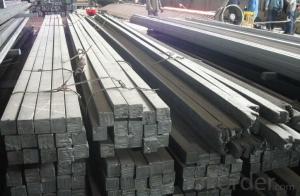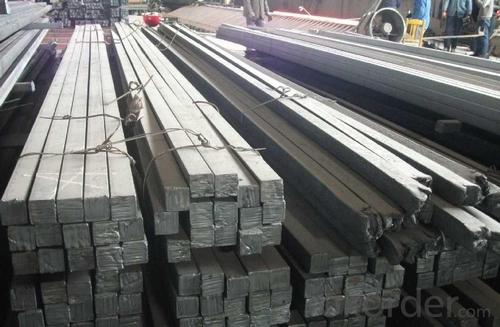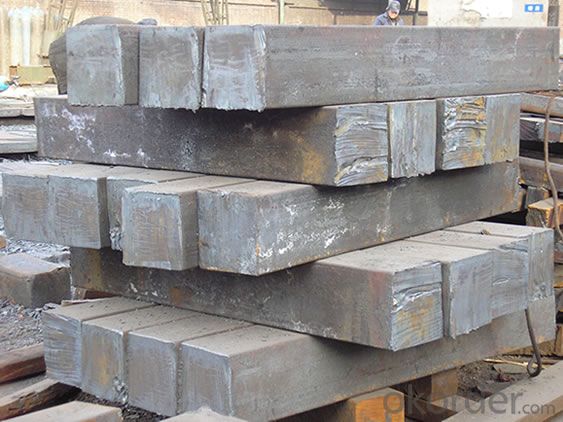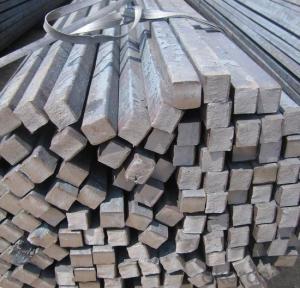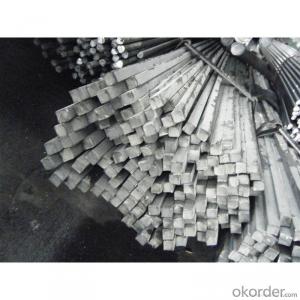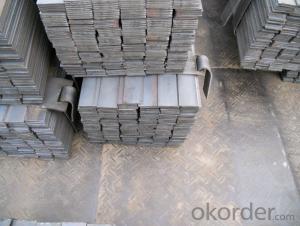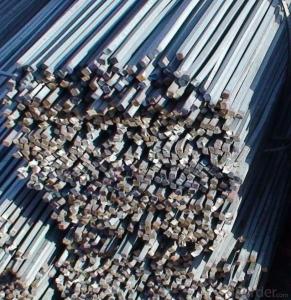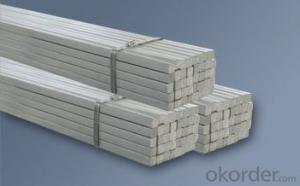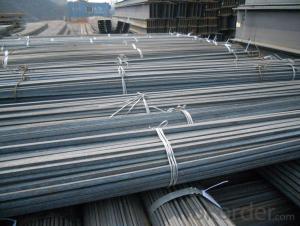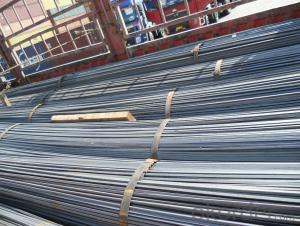High Quality GB Standard Steel Square Bar 26mm-30mm
- Loading Port:
- Tianjin
- Payment Terms:
- TT OR LC
- Min Order Qty:
- 25 m.t
- Supply Capability:
- 10000 m.t/month
OKorder Service Pledge
OKorder Financial Service
You Might Also Like
Product Description:
We offer Square Steel Bar with grade Q195 / Q235
Specifications of Square Steel Bar:
-Standard: GB,
-Grade: Q195/Q235 or equivalent.
Chemical Composition:
-Chemical Composition. Q195
Standard | Grade | Element (%) | ||||
GB | Q195 | C | Mn | S | P | Si |
0.06~0.12 | 0.25~0.50 | ≤0.050 | ≤0.045 | ≤0.30 | ||
-Chemical Composition. Q235
Standard | Grade | Element (%) | ||||
GB | Q235B | C | Mn | S | P | Si |
0.12~0.20 | 0.30~0.70 | ≤0.045 | ≤0.045 | ≤0.30 | ||
Measures and Tolerances of Square Steel Bar:
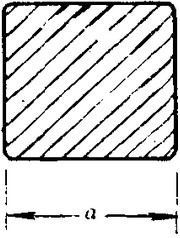
(The section of Square Steel Bar)
-The length of a side and the theoretical weight of Square Steel.
Length of a side(a, mm) | Theoretical weight(kg/m) | Length of a side(a, mm) | Theoretical weight(kg/m) |
6 | 0.283 | 32 | 8.04 |
7 | 0.385 | *33 | 8.55 |
8 | 0.502 | 34 | 9.07 |
9 | 0.636 | *35 | 9.62 |
10 | 0.785 | 36 | 10.17 |
11 | 0.950 | 38 | 11.24 |
12 | 1.13 | 40 | 12.56 |
13 | 1.33 | 42 | 13.85 |
14 | 1.54 | 45 | 15.90 |
15 | 1.77 | 48 | 18.09 |
16 | 2.01 | 50 | 19.63 |
17 | 2.27 | 53 | 22.05 |
18 | 2.54 | *55 | 23.6 |
19 | 2.82 | 56 | 24.61 |
20 | 3.14 | *58 | 26.4 |
21 | 3.46 | 60 | 28.26 |
22 | 3.80 | 63 | 31.16 |
*23 | 4.15 | *65 | 33.17 |
24 | 4.52 | *68 | 36.3 |
25 | 4.91 | 79 | 38.49 |
26 | 5.30 | 75 | 44.16 |
*27 | 5.72 | 80 | 50.24 |
28 | 6.15 | 85 | 56.72 |
*29 | 6.60 | 90 | 63.59 |
30 | 7.06 | 95 | 70.85 |
*31 | 7.54 | 100 | 78.50 |
Notes:
1, The theoretical weights in the list, base on the density of 7.85 g/cm3.
2, The numbers with *mean that they are not regulars or we don’t offer them.
-The allowed tolerance of Square Steel:
Length of a side(mm) | Allowed Tolerance | ||
Group1 | Group2 | Group3 | |
5.5~7 | ±0.20 | ±0.30 | ±0.40 |
7~20 | ±0.25 | ±0.35 | ±0.40 |
20~30 | ±0.30 | ±0.40 | ±0.50 |
30~50 | ±0.40 | ±0.50 | ±0.60 |
60~80 | ±0.60 | ±0.70 | ±0.80 |
80~110 | ±0.90 | ±1.0 | ±1.1 |
110~150 | ±1.2 | ±1.3 | ±1.1 |
150~190 | ―― | ―― | ±2.0 |
190~250 | ―― | ―― | ±2.5 |
Usage/Applications of Steel Square Bar:
-The Square Steel is normally used as structure steel.
-Row material for other structure steel like steel angles, channels, I-beams, H-beams, etc…
Packaging & Delivery of Steel Square Bar:
-Packing Detail: The products can be packed in bundles by steel wires.
-Marks:
1, Tag marks: the tag marks will be tied up to each bundle of the products. The information is usually including supplier’s logo and name, product name, made in China, products’ specifications, the painted color and other information requested by customers.
2, Color marks: we will paint both ends of the bundles of these products to make sure that they are more evident. It’s will be more convenient for the customers to distinguish them at the destination port.
-Delivery Detail: 30~45 working days after receive buyer’s T.T. or L/C.
Transportation:
-The products can be delivered by bulk vessel or by container. As for container, products with the length of 6m will be loaded in 20’ container, with 9m or 12m, in 40’ container.
-The maximum quantity of loading of container is 25 tons.
-The products usually are transported to the nearest port from the production place.
- Q: How do you use a steel square to determine the slope of a staircase?
- To use a steel square to determine the slope of a staircase, you can place one leg of the square on the vertical riser and the other leg on the horizontal tread. By measuring the rise and run or the height and depth of each step, you can calculate the slope or pitch of the staircase using the measurements obtained from the steel square.
- Q: How is a steel square used in carpentry?
- A steel square, also known as a framing square or carpenter's square, is a versatile tool that is widely used in carpentry for various purposes. It consists of two arms, typically 24 inches long, joined at a right angle. One arm is called the blade, and the other is called the tongue. One of the most common uses of a steel square in carpentry is for determining and marking right angles. Carpenters use it to ensure that corners and joints are perfectly square. By placing the square against a board or surface, they can confirm if the angles are 90 degrees. If not, adjustments can be made accordingly to ensure accuracy and precision in the construction process. In addition to checking right angles, a steel square is also used for measuring and marking cuts. The blade of the square is marked with various measurements, such as inches and centimeters, allowing carpenters to take precise measurements quickly. This helps in accurately marking the length and width of boards or pieces that need to be cut, ensuring proper fitment and reducing errors. Another application of a steel square is for laying out and marking angles other than 90 degrees. The tongue of the square is marked with degree increments, making it easy for carpenters to measure and mark angles of different degrees. This is particularly useful when working on projects that require angled cuts, such as roof rafters or staircases. Furthermore, a steel square can be used as a guide for making straight cuts with a circular saw or jigsaw. By aligning the blade of the saw against the blade of the square, carpenters can ensure a straight and accurate cut. Overall, a steel square is an indispensable tool in carpentry, providing carpenters with the ability to check right angles, measure and mark cuts, and lay out angles with precision. Its versatility and accuracy make it an essential tool for both professional carpenters and DIY enthusiasts.
- Q: How do you use a steel square to find angles for compound bevel coping cuts?
- To use a steel square to find angles for compound bevel coping cuts, follow these steps: 1. Begin by understanding the concept of compound bevel coping cuts. These cuts are typically made on the ends of two intersecting pieces of wood or other materials, where one piece is coped to fit snugly against the other piece. Compound bevel coping cuts involve two angles: the miter angle, which determines the horizontal cut, and the bevel angle, which determines the vertical cut. 2. Start by measuring the angle of the miter cut. Place the steel square against the face of the material you want to cut, with the long edge of the square aligned with the edge of the material. Adjust the square until the inside corner of the square aligns perfectly with the edge of the material. Read the angle measurement on the square's scale, which is usually marked in degrees. 3. Once you have determined the miter angle, you need to find the bevel angle. To do this, place the steel square against the edge of the material, with the long edge of the square aligned with the edge. Adjust the square until the inside corner of the square aligns perfectly with the edge of the material. Read the angle measurement on the square's scale. 4. Now, you have both the miter angle and the bevel angle. These angles can be used to set up your compound miter saw or other cutting tool to make the compound bevel coping cuts. Consult the user manual or instructions for your specific cutting tool to learn how to adjust the angles accordingly. 5. Once you have set up your cutting tool with the correct miter and bevel angles, carefully position your material and make the cuts accordingly. Take your time and ensure that you are accurately following the measurements and angles you determined with the steel square. Remember, practice and precision are key when making compound bevel coping cuts. It may take some trial and error to achieve the perfect fit between the coped piece and the other material, so be patient and make adjustments as needed.
- Q: Can a steel square be used for tile corner layout?
- Tile corner layout can be done using a steel square. A steel square, also called a framing square or carpenter's square, is a versatile tool suitable for various layout tasks, including tile corner layout. Its right-angle shape is perfect for guaranteeing accurate and precise corners while laying tiles. By positioning the steel square against the tile corner, you can ensure proper alignment and squareness between tiles. This is especially handy when dealing with large tiles or intricate tile patterns that require precise corner alignment.
- Q: How do you use a steel square to find the length of a rafter?
- To determine the length of a rafter using a steel square, follow these steps: 1. Position the steel square at the end of the rafter board, placing the shorter arm (tongue) against the board's edge. 2. Align the longer arm (body) of the square parallel to the rafter board's length. 3. Once the square is correctly placed, mark the point where the longer arm intersects the rafter board. 4. Proceed to slide the square along the rafter's length, making sure the shorter arm maintains contact with the board's edge. 5. Mark the rafter board at each point where the longer arm crosses it. 6. After marking multiple points along the rafter's length, connect the marks with a straight line. 7. Finally, measure the length of the straight line you drew, which represents the rafter's length. By utilizing a steel square in this manner, you can ensure precise measurements and easily obtain the rafter's length.
- Q: Can a steel square be used for checking the squareness of a countertop?
- No, a steel square is not suitable for checking the squareness of a countertop. Steel squares are typically used for measuring and marking right angles in woodworking and metalworking projects. However, when it comes to checking the squareness of a countertop, specialized tools such as a carpenter's square or a framing square would be more appropriate. These squares are specifically designed for accurately measuring and verifying right angles, making them more reliable for ensuring the squareness of a countertop.
- Q: How do you use a steel square to check for levelness on a countertop?
- To use a steel square to check for levelness on a countertop, you can follow these steps: 1. Start by ensuring that the countertop is clean and free from any debris or objects that could affect the accuracy of the measurement. 2. Place the steel square vertically against the edge of the countertop. Make sure that one side of the square rests flat against the countertop surface, while the other side is perpendicular to it. 3. Check the bubble level on the steel square. The bubble level indicates whether the countertop is level or not. If the bubble is centered between the lines, it means that the countertop is level. If it is off-center, it indicates that the countertop is not level. 4. To further assess the levelness, move the steel square along different areas of the countertop. Repeat the process by placing the steel square against the edge, checking the bubble level, and adjusting as needed. 5. Pay particular attention to any areas where the steel square indicates that the countertop is not level. This could be an indication of an uneven surface or improper installation. 6. If you find any significant discrepancies in levelness, it may be necessary to contact a professional or follow manufacturer guidelines for adjustments or repairs. Remember, while a steel square is a useful tool for checking levelness, it may not be as precise as specialized leveling instruments. If you require a highly accurate measurement, it is advisable to consult a professional or use dedicated leveling tools.
- Q: How do you use a steel square to determine the angle of a compound miter bevel cut?
- To use a steel square to determine the angle of a compound miter bevel cut, you will need to follow a few steps. First, place your steel square on the workpiece, ensuring that one of the arms is aligned with the edge of the material. This arm will act as the reference for measuring the angle. Next, adjust the steel square to the desired angle for the miter cut. You can accomplish this by rotating the square until the desired angle is achieved. Once the steel square is set at the desired angle, mark the angle on the workpiece using a pencil or a marking knife. This will serve as a guide when making the cut. After marking the angle, set up your compound miter saw or other cutting tool according to the marked angle. This will ensure that the cut is made accurately. Finally, carefully make the cut along the marked line, ensuring that the workpiece is securely held in place to prevent any movement or accidents. Double-check the angle of the cut to ensure accuracy before proceeding with the project.
- Q: What are some common materials used to make steel squares?
- Some common materials used to make steel squares include carbon steel, stainless steel, and aluminum.
- Q: How do you use a steel square to find the square footage of a deck?
- To determine the square footage of a deck using a steel square, there are several straightforward steps you should follow. Firstly, ascertain that you possess a steel square, also referred to as a framing square. This tool has a triangular shape with a lengthy arm and a shorter arm forming a 90-degree angle. To commence, measure the width by positioning the shorter arm of the steel square against the deck's side and aligning it with the edge. Extend the longer arm across the deck's width, ensuring that the steel square is accurately placed with the shorter arm perpendicular to the deck's edge. Next, mark the measurements by tracing along the longer arm of the steel square where it aligns with the deck's edge. This will create a straight line across the deck's width. Subsequently, measure the length by relocating the steel square to the opposite side of the deck. Align the shorter arm with the side edge once again and extend the longer arm along the deck's length, ensuring it remains perpendicular to the side edge. Repeat the marking process by tracing along the longer arm of the steel square where it aligns with the deck's length. This will create a straight line across the deck's length. With the width and length of the deck marked using the steel square, you can now calculate the square footage. Measure the distance between the two width lines you marked and record the measurement. Similarly, measure the distance between the two length lines and note the measurement. Multiply these two measurements together to obtain the square footage of the deck. In the event that your deck incorporates irregular shapes or sections, repeat the aforementioned steps for each area. Subsequently, add the square footage of each section together to obtain the total square footage of the deck. Using a steel square to determine the square footage of a deck is a straightforward and reliable method that ensures accuracy in your calculations.
Send your message to us
High Quality GB Standard Steel Square Bar 26mm-30mm
- Loading Port:
- Tianjin
- Payment Terms:
- TT OR LC
- Min Order Qty:
- 25 m.t
- Supply Capability:
- 10000 m.t/month
OKorder Service Pledge
OKorder Financial Service
Similar products
Hot products
Hot Searches
Related keywords
